The Gay Divorcee (1934)
Leave a commentDecember 30, 2016 by smumcounty
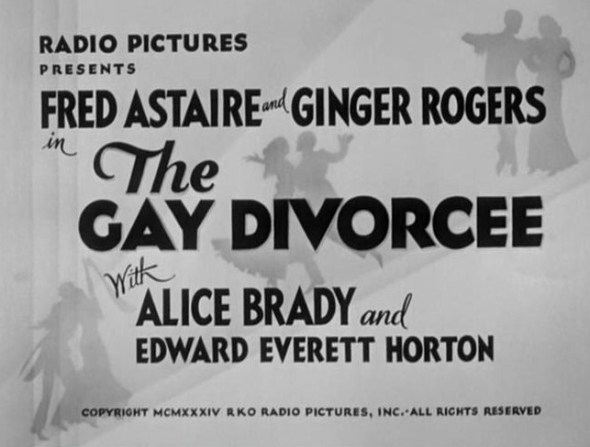 With the recent release of “La La Land” (2016) in theaters, the first big budget musical in many moons, it got me thinking about what makes a great musical and what attracts people to them, or, at least, used to attract people to them. With this in mind, let’s look at one of my favorite musicals, “The Gay Divorcee” (1934).
With the recent release of “La La Land” (2016) in theaters, the first big budget musical in many moons, it got me thinking about what makes a great musical and what attracts people to them, or, at least, used to attract people to them. With this in mind, let’s look at one of my favorite musicals, “The Gay Divorcee” (1934).
This film was the second pairing of RKO’s legendary musical talents Fred Astaire and Ginger Rogers. Their first film together was “Flying Down to Rio” (1933) which starred Dolores Del Rio and Gene Raymond, relegating Astaire and Rogers to second couple billing. After the success of this film, RKO liked what they saw in this dancing couple and purchased the rights to the Broadway musical “The Gay Divorce”, which had starred Astaire, with the intention of making it into a vehicle for Astaire and Rogers.
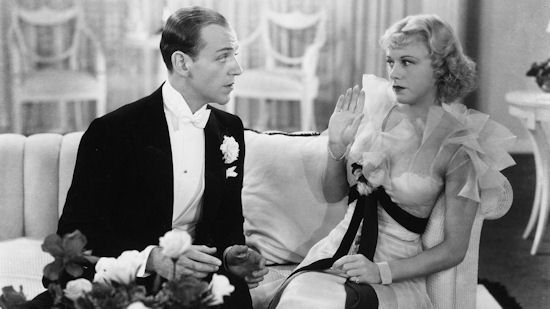
Fred Astaire and Ginger Rogers
Like most musicals, this one consists of the thinnest of plots: Mimi Glossip (Ginger Rogers) has traveled to London with the intention of getting a divorce from her estranged husband Cyril (William Austin) whom she has not seen for several years but who has thus far refused to let her go. With advice from her oft-divorced aunt Hortense (Alice Brady) she approaches bumbling lawyer Egbert Fitzgerald (Edward Everett Horton), a one-time fiancé of her aunt. Egbert explains that in order to force Cyril to divorce her they need to arrange for Mimi to be found in a love tryst with a strange man by detectives whom he will hire. For this, Egbert arranges a meeting at a seaside hotel between Mimi and a professional co-respondent by the name of Rodolfo Tonetti (Erik Rhodes). Egbert and Hortense accompany Mimi to the resort in order to see that everything goes smoothly and where Tonetti will later join them.
American hoofer Guy Holden (Fred Astaire) has previously met Mimi in London and has fallen instantly in love with her (as these things will happen). By chance, he is a friend of Egbert’s whom Egbert has invited to spend the weekend with him at the resort. Of course, Mimi runs into Guy at the resort, and while first attracted to him, she is later put off when, through no fault of his own, he is mistaken by Mimi for the professional co-respondent she was meant to meet at the resort.
So, check. The thinnest of plots is all you need, but if we’re talking a love story, as here, it’s got to be contrived to keep the young lovers separated just long enough to get through a few musical numbers. Double check. But there’s more to this film than a love story punctuated with singing and dancing. This plot is also wacky enough to provide some light comedy, and this is where this musical distinguishes itself, in the wonderful comedic writing. For this is a great comedy as well as a great musical and in addition to the musical interludes we also get some wonderful comedic turns. Take this exchange between Egbert and Guy, for example, as Guy tries to describe the object of his affection:
Guy: I know. I know. But not like her. She’s music. She’s the buzzing of the bees in clover. She’s the rustle of the leaves in the trees. She’s water lapping on the shore.
Egbert: She sounds like a series of strange noises to me.
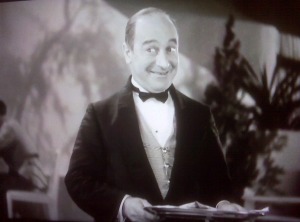
Eric Blore
That one had me LOL’ing. Shortly thereafter, Eric Blore and Horton have a wonderful exchange where Blore as a waiter at the resort attempts to divine what Horton will have to eat. The scene plays like a vaudeville number with Horton portraying his signature role of a dignified person undone by life’s vicissitudes and with Blore playing his usual wacky servant. After multiple viewings, I’m still unable to discern whether Blore’s waiter is sincere in his attempts or is just toying with the easily undone Horton. “Well, that lands both of us in a cul-de-sac. Doesn’t it, sir?” Love it! Blore was one of the original cast members from the Broadway production who was asked to reprise his role for the film version. You can easily see why:

Alice Brady
It is in the use of seasoned character actors like Horton and Blore that “The Gay Divorcee” excels comedically. Besides Horton and Blore we also have Alice Brady who was known for playing flighty matrons like Aunt Hortense here and as Carole Lombard’s mother in “My Man Godfrey” (1936). Horton and Brady make up the second romantic couple in this film with Hortense convinced that Egbert must still be pining for her and Egbert determined to evade any entanglements. The film takes it up a notch whenever these two are sparring.
Egbert: Well, it’s no crime to be married. It’s just shows a weakness on the part of men that women take advantage of.
Hortense: Oh, Egbert. Are you proposing to me again?
Egbert: No… No, no!
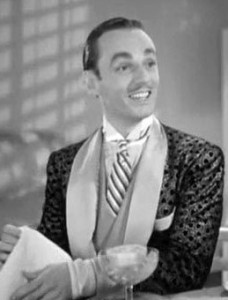
Erik Rhodes
And let’s not forget Erik Rhodes in another delightful comic turn as Tonetti. Like Blore, Rhodes got his start in Hollywood with “The Gay Divorcee”. His portrayal of the feather-brained, thick-accented, effete Italian in the Broadway version brought him to the attention of RKO who hired him to reprise this role in the film. As a professional co-respondent, Tonetti takes great pride in his work (“Your wife is safe with Tonetti. He prefers spaghetti.”) and objects to the perceived interference of Guy. Though born in Oklahoma, Rhodes’ Italian character is so convincing you would swear he was from the old country. He later went on to play the same sort of Italian character in another great Astaire and Rogers pairing, “Top Hat” (1935).
So, comedy, check. But in any great musical you’ve got to have great musical numbers and as you would expect from an Astaire/Rogers musical, this one doesn’t disappointment. The first couple of musical interludes, to the songs “Don’t Let It Bother You” and “Needle in a Haystack”, show off Astaire’s tap dancing and they are as impressive as one would expect, one of the greatest of tap dancers at the height of his powers.
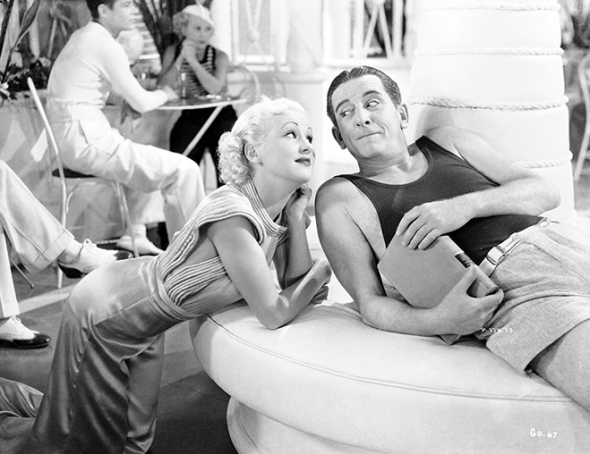
Betty Grable and Edward Everett Horton about to K-nock K-nees
I particularly enjoyed the next musical number, “Let’s K-nock K-nees”, since it combined both dancing and comedy. In it, a guest of the seaside hotel (Betty Grable of later 40’s pinup fame) encourages Egbert, dressed in shorts and sandals with socks, to engage in the newest of dances where the contestants knock their knees together. As Betty Grable sings to him, Egbert, as one would expect, is at first shocked by the young woman’s attentions but he eventually gives in and starts singing and dancing, such as it is, with her. Later the entire hotel is performing this insanely silly dance. The number is filled with 30’s style cornpone but is saved by the comedic turn of Horton and the adorableness of the young Betty Grable. Corny, yes, but the corn has become charming with the passage of time.
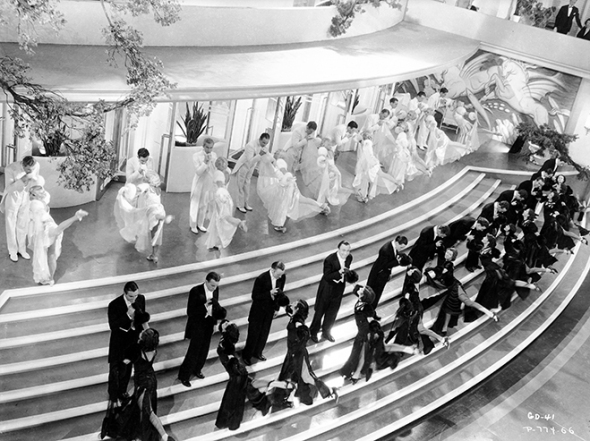
The Continental
The first Astaire/Rogers pairing in “Flying Down to Rio” (1933) included a number which introduced a new dance to the nation, “The Carioca”, and this film attempts to accomplish the same with “The Continental”. This is a big production number beginning with Astaire and Rogers dancing alone and then including two dozen dancers dressed in either all black or all white formal wear. The color coordination (gray-scale coordination?) reminds me of a Busby Berkeley number without the overhead kaleidoscope shots. I don’t know if the dance ever caught on but the song went on to win the first Academy Award for Best Original Song. The number goes on for quite some time with Tonetti even getting in on it by singing a few verses. For me, however, it is the weakest of the musical numbers.
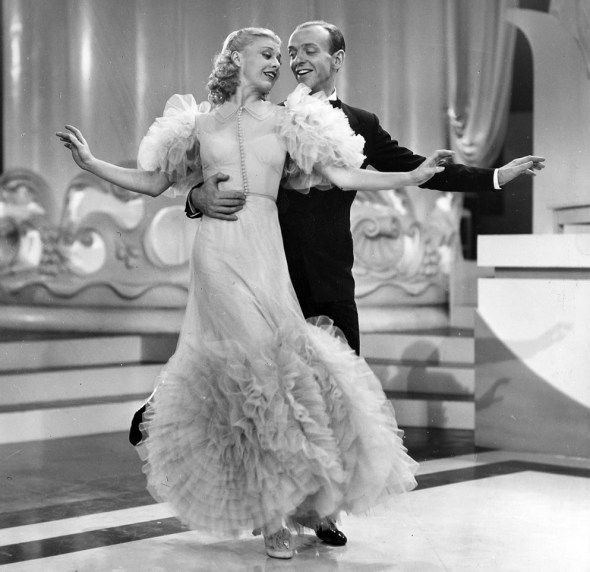
Night and Day
A much more enjoyable and classic pairing of Astaire and Rogers comes with the “Night and Day” number, set to the classic Cole Porter song. There were a number of Cole Porter songs in the original Broadway production but this is the only to survive in the film adaptation. Here you’ve got both Astaire and Rogers dressed to the nines doing the kind of ballroom style dancing they are best known for. This is also a nice number since you can see by the end Mimi has finally been swept off her feet by Guy, both literally and figuratively.
So, unobtrusive plot, dancing, singing, and comedy. That’s about it, but to my mind “The Gay Divorcee”, is the best of the Astaire and Rogers musicals. All the films have great dancing but this one is notable because of its attention to the comic aspects of the plot. As evidenced by this post, people are still watching and enjoying “The Gay Divorcee” more than 80 years after its initial release. Will “La La Land” enjoy a similar longevity? It’s hard to know what films will have staying power on their first release but if it’s able to combine the music, dancing, and comedy of “The Gay Divorcee” it will have a fighting chance. I’ve not yet seen the film, but, from what I’ve read, “La La Land” has the singing and dancing down. I imagine Ryan Gosling is at least as good a singer as Fred Astaire though likely not as great a dancer. But the comedy is likely not there, unless I’m grossly misinterpreting Rotten Tomatoes.
Trivia
- The name change from “The Gay Divorce” to “The Gay Divorcee” was due to the objection of the Hays Office which was enforcing the motion picture production code at the time. The Hays Office reasoned that a divorcee can be considered gay or lighthearted but to believe that a divorce could be so was somehow improper. It’s funny what the prudes of the day concerned themselves with.
